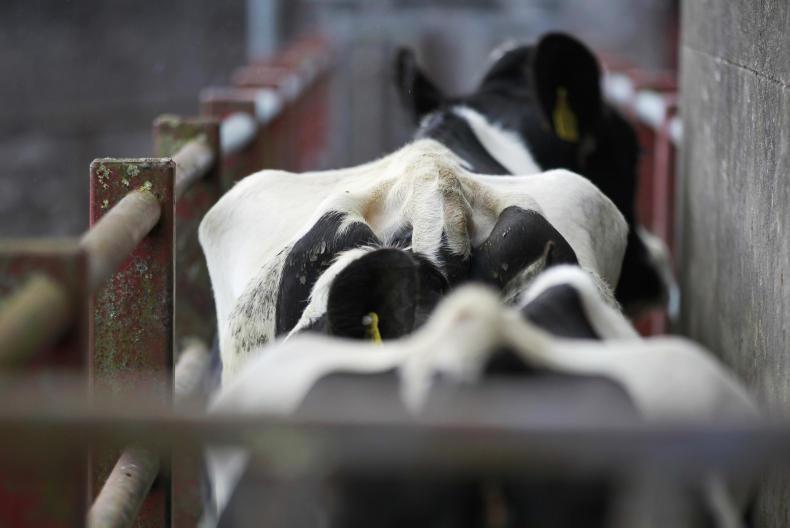Over the last few days I have heard from a number of farmers complaining about the number of cows they are observing in heat that they presumed were in-calf.
In many cases, the cows were last served six to nine weeks ago. Seeing cows come bulling now, this late in the breeding season, is very disappointing.
Were they bulling previously and were missed or did they conceive and subsequently break down? In most cases we will never know the real reason but it is likely to be caused by a combination of both.
Seeing cows bulling now is a worry. The fear is that there will be more cows cycling over the coming days and that empty rates will be higher than normal, particularly as most farmers will be planning to finish breeding in the next week or so.
Vigilance
At this stage there is not a lot that can be done other than being vigilant for cows bulling and making sure they are served.
If bulls are out, make sure the bulls are covering all cows. Don’t be afraid to AI cows if there are a few bulling in the one day.
Some level of embryo mortality is unavoidable. Research says that between 5% and 10% of all pregnancies will result in losses.
Causes
The cause of this is unknown, and while some farmers and vets blame excess nitrogen uptake, the scientists are not in agreement that this is the true cause.
Of bigger concern is disease outbreak. Viral diseases like BVD and IBR could cause embryo mortality, but an outbreak of these diseases would cause other symptoms also such as drop in milk yield, high temperatures, snotty noses, etc.
Poor nutrition could also be a risk factor, but again, it is highly unlikely that this would only present itself as embryo mortality. Body condition score and milk yield would probably be affected before cows would lose pregnancies.
Frustration
In conclusion, seeing cows bulling that were previously thought to be in-calf is disappointing and frustrating but there is no real direct cause of it. There is always some degree of embryo loss.
It is magnified due to poor nutrition or a disease outbreak.
If worried, calculate how many cows have broken down over the past three weeks and compare that with the non-return rate from the first service.
Normally, a good conception rate to first service is around 55 to 60%.
Often, non-return rates would be in excess of 70%. Losing 5% to 10% of pregnancies now will probably only bring back conception rates to normal accepted levels.
The other thing to bear in mind is that, with bigger numbers of cows on many farms, the actual number of cows empty at the end of the breeding season might be a lot more, but the percentages could still be the same.
Dairy management: milk recording
Monday Management: improving milk protein percent
Over the last few days I have heard from a number of farmers complaining about the number of cows they are observing in heat that they presumed were in-calf.
In many cases, the cows were last served six to nine weeks ago. Seeing cows come bulling now, this late in the breeding season, is very disappointing.
Were they bulling previously and were missed or did they conceive and subsequently break down? In most cases we will never know the real reason but it is likely to be caused by a combination of both.
Seeing cows bulling now is a worry. The fear is that there will be more cows cycling over the coming days and that empty rates will be higher than normal, particularly as most farmers will be planning to finish breeding in the next week or so.
Vigilance
At this stage there is not a lot that can be done other than being vigilant for cows bulling and making sure they are served.
If bulls are out, make sure the bulls are covering all cows. Don’t be afraid to AI cows if there are a few bulling in the one day.
Some level of embryo mortality is unavoidable. Research says that between 5% and 10% of all pregnancies will result in losses.
Causes
The cause of this is unknown, and while some farmers and vets blame excess nitrogen uptake, the scientists are not in agreement that this is the true cause.
Of bigger concern is disease outbreak. Viral diseases like BVD and IBR could cause embryo mortality, but an outbreak of these diseases would cause other symptoms also such as drop in milk yield, high temperatures, snotty noses, etc.
Poor nutrition could also be a risk factor, but again, it is highly unlikely that this would only present itself as embryo mortality. Body condition score and milk yield would probably be affected before cows would lose pregnancies.
Frustration
In conclusion, seeing cows bulling that were previously thought to be in-calf is disappointing and frustrating but there is no real direct cause of it. There is always some degree of embryo loss.
It is magnified due to poor nutrition or a disease outbreak.
If worried, calculate how many cows have broken down over the past three weeks and compare that with the non-return rate from the first service.
Normally, a good conception rate to first service is around 55 to 60%.
Often, non-return rates would be in excess of 70%. Losing 5% to 10% of pregnancies now will probably only bring back conception rates to normal accepted levels.
The other thing to bear in mind is that, with bigger numbers of cows on many farms, the actual number of cows empty at the end of the breeding season might be a lot more, but the percentages could still be the same.
Dairy management: milk recording
Monday Management: improving milk protein percent






 This is a subscriber-only article
This is a subscriber-only article










SHARING OPTIONS: